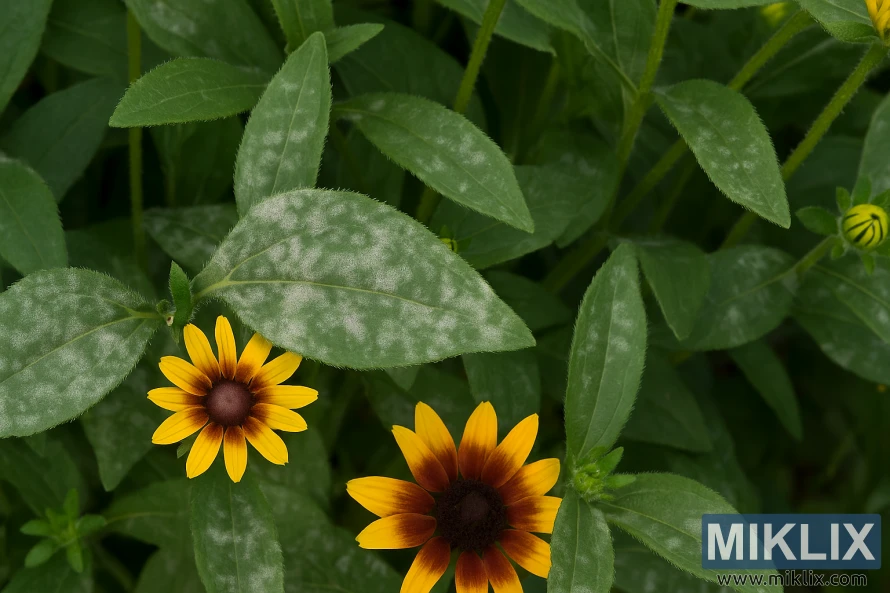Image: Powdery Mildew on Black-Eyed Susan Leaves
Published: October 27, 2025 at 9:10:27 PM UTC
High-resolution close-up photograph showing powdery mildew on Black-Eyed Susan leaves, featuring white fungal patches on green foliage with bright yellow flowers in natural summer light.
This high-resolution, landscape-format photograph presents a close-up view of Black-Eyed Susan (Rudbeckia hirta) foliage showing the characteristic symptoms of powdery mildew, a common fungal disease affecting garden plants. Captured under soft natural light, the image balances scientific accuracy with aesthetic clarity, illustrating the contrast between the plant’s healthy green leaves and the pale, powdery coating typical of infection. The composition offers both context and detail: several leaves fill the frame in overlapping layers, with the white fungal growth clearly visible across their surfaces, while the familiar golden flowers of the Black-Eyed Susan peek from the lower edge of the image, adding a touch of color and vitality.
At the center of the photograph, one large leaf is in sharp focus, displaying an extensive spread of powdery mildew. The fungal coating appears as irregular, whitish-gray blotches concentrated along the veins and midrib, gradually thinning toward the edges. The texture of the mildew is faintly velvety, with individual patches merging into a thin film that dulls the leaf’s natural gloss. Around it, other leaves show varying stages of infection — some with light speckling, others with dense, chalky deposits — providing a sense of the disease’s progressive nature. The healthy portions of the foliage remain deep green, their coarse, slightly hairy texture visible beneath the mildew’s overlay.
The two bright flowers in the lower third of the frame introduce an immediate visual contrast. Their petals — golden yellow with touches of russet near the centers — radiate outward from dark brown domes, pristine and unblemished. They serve as a poignant reminder of the plant’s natural beauty, even as disease begins to claim its leaves. Around the flowers, unopened buds suggest continued growth and resilience, lending the scene both scientific interest and emotional balance.
The background is softly blurred, composed of overlapping leaves and stems rendered in varying shades of green. This shallow depth of field draws attention to the infected leaves in the foreground, making them the focal point while preserving the overall impression of a thriving, dense planting. A hint of sunlight filtering through the foliage creates subtle highlights along the edges of the leaves, emphasizing their three-dimensional form and the spread of mildew across the textured surfaces.
In terms of composition, the photograph achieves a delicate equilibrium between diagnosis and beauty. It documents the distinct visual pattern of powdery mildew — the mottled, dusty white appearance on green foliage — in a way that could serve both educational and artistic purposes. The color contrast between the infected leaves and the vivid flowers enhances the storytelling quality: even in the face of imperfection, the plant continues to bloom.
Scientifically, the image captures a typical manifestation of Erysiphe cichoracearum or related fungi, which thrive in warm, humid conditions with limited airflow. The fine resolution reveals the mildew’s powdery texture, enabling identification by horticulturalists or gardeners. Artistically, the interplay of greens, yellows, and whites under natural daylight evokes a feeling of realism and immediacy — the kind of quiet observation one makes while tending a summer garden.
Overall, this photograph stands as both an accurate visual record and an aesthetically thoughtful depiction of a common garden challenge. It invites the viewer to see disease not as mere blight, but as part of the natural cycle — a reminder of the balance between beauty and imperfection in every living landscape.
The image is related to: A Guide to the Most Beautiful Varieties of Black-Eyed Susan to Grow in Your Garden

